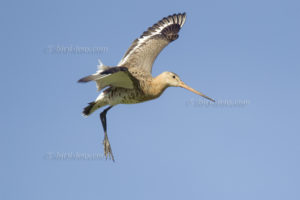 A satellite transmitter packed on a juvenile Black-tailed Godwit (Limosa limosa) called “Christiansieneson” recorded a save landing the Inner Niger Delta in Mali. The Black-tailed Godwit has made the more than 4,100 kilometers from the wetlands of the Duemmer (south of Bremen in northern Germany) down to the African wintering area in record time and virtually in one go. This was the result of the evaluation of a satellite transmitter, which the young bird had received as one of 25 Black-tailed Godwits in the LIFE project ” Wiesenvoegel “, which means Meadow birds. The project is managed by the Niedersächsische Landesbetrieb für Wasserwirtschaft, Küsten- und Naturschutz (NLWKN). Since 2018, 25 Black-tailed Godwits had been equipped with satellite transmitters. These satellite transmitters are extremely light at five grams and are worn like a backpack.
A satellite transmitter packed on a juvenile Black-tailed Godwit (Limosa limosa) called “Christiansieneson” recorded a save landing the Inner Niger Delta in Mali. The Black-tailed Godwit has made the more than 4,100 kilometers from the wetlands of the Duemmer (south of Bremen in northern Germany) down to the African wintering area in record time and virtually in one go. This was the result of the evaluation of a satellite transmitter, which the young bird had received as one of 25 Black-tailed Godwits in the LIFE project ” Wiesenvoegel “, which means Meadow birds. The project is managed by the Niedersächsische Landesbetrieb für Wasserwirtschaft, Küsten- und Naturschutz (NLWKN). Since 2018, 25 Black-tailed Godwits had been equipped with satellite transmitters. These satellite transmitters are extremely light at five grams and are worn like a backpack.
Unlike most of his conspecifics, “Christiansieneson” flew the route without long stops and did not take the “classical” route of other tracked birds. On July 15, the juvenile was located at lunchtime in the breeding area, on July 16, the Godwit already flew over Algeria. Just under 55 hours after leaving Duemmer, the bird finally reached the Inner Niger Delta in Mali. “Christiansieneson” flew on average 74 kilometers per hour.
The evaluation of the birds equipped with satellite transmitter in 2019 in the EU bird sanctuary Duemmer shows that these migrate significantly later than the 2018 consigned conspecifics from the breeding area. This is not easy to explain, but it might be due to better food availability in long-flooded areas through targeted damming, which provide a good resting and feeding area in dry summer. It also showed that this year’s Godwits did not stop in the Dutch intermediate resting areas – in contrast to last year. The other young birds equipped with satellite transmitter are currently still resting in western France and Spain. In these areas, which included the “Coto de Doñana” national park in southern Spain, a large part of the birds of both years rested. The satellite data also shows that Black-tailed Godwits can pause for more than a month in intermediate resting areas until they fly on. Most long-distance migrations birds rest in order to renew and build-up fat reserves. At night the bird migration is started again.
To cope with the growing demand for top shots of the rarer species of the Palearctic Bird-Lens is keen to enrich the range of pictures of birds you can find in the western palearctic. Trips to remote places to capture images not only of rare birds of western palearctic were very successful. The nice image of the blog is only a first impression, what you will find in the gallery in the “Picture Shop” very soon. Just give bird-lens.com a message, if bird-lens.com could serve you with an image needed before the new pictures are online.